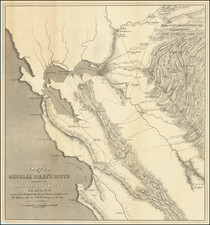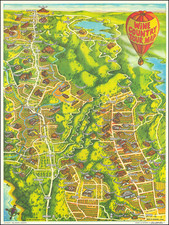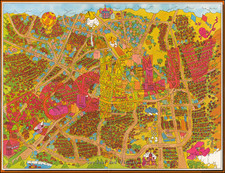Fine early map of Terminal Island, in San Pedro California, drawn for the Southern Pacific Railroad.
The map illustrates Terminal Island at the beginning of its modern history, before the island was substantially reshaped and modified by dredging and reclamation projects that created the modern harbors at San Pedro and Long Beach.
The map show the City of San Pedro at the right, with the lines of the Southern Pacific. Below, a line identified as Los Angeles Terminal Railway traverses Terminal Island, with a railway station, Hotel Site, Mill, Lumber Yard and Coal Yard shown, along with several wharfs. The location of the Catalina Yacht club is also noted (constructed in 1898).
The map shows Morman (Mormon) Island and Smith Island, both of which have also been dramatically reshaped by modern port projects. Mormon Island was the site of an short-lived settlement attempt by San Bernardino-based Mormon pioneers in the 1850s.
Terminal Island
The island was originally called Isla Raza de Buena Gente and later Rattlesnake Island. It was renamed Terminal Island in 1891.
In 1891, the Terminal Land Company purchased the island and a railway was built on to its east side by the Los Angeles Terminal Railroad Company. That year the new owners renamed Rattlesnake Island "Terminal Island" - a somewhat foreboding name, but certainly less unappealing than its former appellation. Meanwhile, the Southern Pacific Railroad's Collis P. Huntington was promoting nearby Santa Monica Bay as a deep harbor and built the Long Wharf there in 1893. In 1897, thanks largely to the efforts of Los Angeles Times publisher Harrison Gray Otis, San Pedro Bay got the federal endorsement and breakwater construction began in 1899. The Los Angeles Board of Harbor Commissioners was founded in 1907. The area, including the towns of San Pedro and Wilmington, were annexed by Los Angeles in 1909.
Toward the end of the 19th century, an upper class resort was established on the southern short (along present day Seaside Avenue between Ferry Street and Navy Way) and named Brighton Beach. The playground of the wealthy included an hotel, a restaurant, a bar, a boardwalk, and roughly 200 cottages.
The upper-class playground--at the time considered second only to Coronado Island in San Diego County--was on present-day Seaside Avenue between Ferry Street and Navy Way in East San Pedro. Electric lights were strung across the boardwalk. At low tide, the beach was a quarter-mile wide, and bathers could wade far out into the water.
Terminal Island was connected to Long Beach by a railroad and a pontoon bridge, now by the Gerald Desmond Bridge. For 5 cents each way, travelers could cross the 500-foot-wide channel on the ferry Blanche, which was launched from San Pedro at the 5th Street Landing. However, schoolboys saved the fare by swimming across the channel, leaving their clothes with one youth who would make the crossing on the ferry. Most of the boys worked on the island's first fish cannery, removing sardine heads.
By 1901, Brighton Beach had become the rallying point for the finest yachts along the coast. Their wealthy owners built a clubhouse and organized Southern California's first recreational boating group. It was called the South Coast Yacht Club and was the forerunner of the Los Angeles Yacht Club. The first official yacht race was held May 30, 1902, from the Brighton Beach wharf to the buoy off San Pedro's Point Fermin.
Brighton Beach came to a fairly abrupt end when a major dredging project shrank the beaches and allowed for the construction of fish canneries which primarily employed Filipinos, Japanese, and Mexicans. No longer attractive to the upper class, many rented out their houses to the newly arrived working class.
In 1909 ,the newly reincorporated Southern California Edison Company decided to build a new steam station to provide reserve capacity and emergency power for the entire Edison system, and to enable Edison to shut down some of its small, obsolete steam plants. Construction of Plant No. 1 began in 1910.
In 1930, the Ford Motor Company built a facility called Long Beach Assembly, having moved earlier operations from Downtown Los Angeles. The factory remained until 1958 when manufacturing operations were moved inland to Pico Rivera.
In 1927 a civilian facility, Allen Field, was established on Terminal Island. The Naval Reserve established a training center at the field and later took complete control, designating the field Naval Air Base San Pedro (also called Reeves Field). In 1941 the Long Beach Naval Station became located adjacent to the airfield. In 1942 the Naval Reserve Training Facility was transferred, and a year later NAB San Pedro's status was downgraded to a Naval Air Station (NAS Terminal Island). Reeves Field as a Naval Air Station was disestablished in 1947, although the adjacent Long Beach Naval Station would continue to use Reeves Field as an auxiliary airfield until the late 1990s.
The Japanese in particular made their mark on the island, establishing a village that they called Furusato and speaking in a dialect that came to be referred to as "kii-shu ben" (most of them originally came from the Kii district in Wakayama). The island was home to about 3,500 first- and second-generation Japanese Americans prior to World War II, in an area known as East San Pedro or Fish Island. Following the attack on Pearl Harbor, all of the adult Issei males on Terminal Island were incarcerated by the FBI on February 9, 1942. Immediately after the signing of Executive Order 9066 on February 19, 1942, the rest of the inhabitants were given 48 hours to evacuate their homes. They were subsequently sent to internment camps, and the entire neighborhood was razed. The Japanese community on Terminal Island was the first to be evacuated and interned en masse.
After World War II, the Terminal Islanders settled elsewhere. In 1971, they formed the Terminal Islanders Club, which has organized various events for its members. In 2002, the surviving second-generation citizens set up a memorial on Terminal Island to honor their parents.
During World War II, Terminal Island was an important center for defense industries, especially shipbuilding. It was also, therefore, one of the first places where African Americans tried to effect their integration into defense-related work on the West Coast.
In 1946, Howard Hughes moved his monstrous Spruce Goose airplane from his plant in Culver City to Terminal Island in preparation for its test flight. In its first and only flight, it took off from the island on November 2, 1947.
Terminal Island was also the birthplace of America's fish canning industry. At its height, it had 18 canneries and provided about 17,000 jobs.
Preservation of vacant buildings earned the island a spot on the top 11 sites on the National Trust for Historic Preservation's 2012 Most Endangered Historic Places List. In mid-2013, the Los Angeles Board of Harbor Commissioners approved a preservation plan.The National Trust for Historic Preservation cited the site as one of ten historic sites saved in 2013.
San Pedro
San Pedro's modern history begins with Phineas Banning, known as "the Father of the Port of Los Angeles." Banning arrived in San Pedro, California, in 1851 at the age of 21. At the time, San Pedro was a small fishing village of San Pedro, just south of the Pueblo of Los Angeles.
Banning's influence in Los Angeles grew quickly. He was elected to a one-year term on the Los Angeles Common Council, the governing body of that city, beginning May 10, 1858, and ending May 9, 1859. He soon began his own staging and shipping company. By the 1860s, Banning wagons were traveling to Salt Lake City, the Kern River gold fields, the new military installation at Yuma, Arizona, the Mormon settlement at San Bernardino, and in an arc around the Southern California region.
In addition to his stage business, Banning began expanding the harbor and docks at San Pedro from their beginnings as illegal exchange sites for mission contraband during the Spanish and Mexican eras, and made them efficient enterprises.
In the late 1850s, Banning and a group of Southern California investors purchased 640 acres of land adjacent to San Pedro for port expansion. The land purchase was incorporated as Wilmington, with the port becoming known as Banning's Landing. Banning invested the profits from his trade networks into the development of a more sophisticated port complex and for the creation of roads, telegraphs, and other connections to Los Angeles. In 1859, the first ocean-going vessel anchored in Los Angeles-Wilmington harbor, and the 1860s saw the beginning of small-scale maritime trade between San Pedro and ships anchored in the deeper parts of the harbor. After government-funded dredging made a deep water harbor and breakwater a reality, the port continued to grow.
In the late 1860s, Banning began construction of Southern California's first railroad, the Los Angeles & San Pedro Railroad which he sold to the Southern Pacific Railroad in 1873. As a California state senator, Banning prioritized creation of greater transportation connections to Los Angeles and San Pedro. Banning eventually pushed through a plan for a small railroad linking Wilmington/San Pedro with the main city of Los Angeles, effectively halving the time necessary for the trip, but the plan was short-lived. The Southern Pacific Railroad began building track to connect Southern California to the greater national railroad lines, and demanded much of Los Angeles' prime real estate, an enormous sum of money, and Banning's small connector line railroad, in exchange for adding Los Angeles as a terminus on the railroad. Realizing that Los Angeles would wither into nothingness if the company bypassed it, the city complied and Banning surrendered his hard-earned railroad.
In 1873, the first breakwater was built. In 1888, the US War Department took control of a tract of land next to the bay and added to it in 1897. The efforts to develop the port as the official port of Los Angeles came to fruition in 1897, when Congressman Stephen M. White pushed through leglislation that made San Pedro the official port of Los Angeles.











![[ Southern California Tourism ] Hunting and Fishing in Southern California on the Santa Fe](https://storage.googleapis.com/raremaps/img/small/101613.jpg)
![[First Obtainable Map to Name California] Tartariae Sive Magni Chami Regni typus](https://storage.googleapis.com/raremaps/img/small/82510.jpg)

![[ Death Valley - Furnace Creek Ranch ]](https://storage.googleapis.com/raremaps/img/small/98985.jpg)